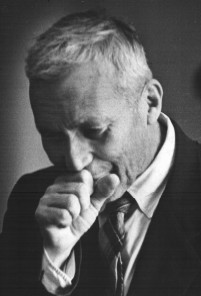
BIOGRAPHY OF Andrej N. KOLMOGOROV
( 1903 - 1987 )
-
born April 25, 1903, Tambov, Russia.
died October 20, 1987, Moscow.
|
|
BIOGRAPHY OF Andrej N. KOLMOGOROV
|
Andrej N. KOLMOGOROV was one of the most prominent twentieth-century mathematicians.
Throughout his mathematical work, A.N. Kolmogorov (1903-1987) showed great creativity and versatility and his wide-ranging studies
in many different areas led to the solution of conceptual and fundamental problems and the posing of new, important questions.
His lasting contributions embrace probability theory and statistics, the theory of dynamical systems, mathematical logic, geometry and topology,
the theory of functions and functional analysis, classical mechanics, the theory of turbulence, and information theory.
Andrei Nikolaevich Kolmogorov made major contributions to
almost all areas of mathematics and many fields of science and
is considered one of the 20th century's most eminent
mathematicians. He was the founder of modern probability
theory, having formulated its axiomatic foundations and
developed many of its mathematical tools. Kolmogorov also
helped make advances in many applied sciences, from physics
to linguistics. A great teacher, he did much to keep the Soviet
Union in the forefront of research in theoretical and applied
mathematics and was responsible for reforms in mathematics
education at the elementary and high-school levels.
Kolmogorov was born in
the town of Tambov in central Russia on April 25, 1903. His father,
Nikolai Kataev, became a professional
agriculturalist and was
killed during World War I. His mother, Mariya Yakovlevna Kolmogorova, was not
formally married to his father and died during his birth. Her sister, Vera Yakovlevna
Kolmogorova, adopted and raised the boy in the family's home
village of Tunoshna. As a child, young Kolmogorov and his
friends attended a school run by his two aunts. At the age of
five, he made his first mathematical discovery by noticing the
pattern that 1=12, 1+3=2 2, 1+3+5=32, etc.
In 1920, at the age of 17, Kolmogorov enrolled in Moscow
University. To help support himself while he attended the
university, he worked as a secondary school teacher. He took
an active role in the school, and he is said to have been more
proud of that work than of the honors he garnered for his own
academic progress. Within two years, Kolmogorov had
completed a study in the theory of operations on sets, which
was eventually published in 1928. A second project he also
completed in 1922 brought immediate recognition: He
formulated the first known example of an integrable function
with a Fourier series that diverged almost everywhere (he
soon extended that result to everywhere). The international
mathematics community took notice of the bright 19-year-old.
During his years as a university student, he published 18
mathematical papers including the strong law of large numbers,
generalizations of calculus operations, and discourses in
intuitionistic logic. In 1925, Kolmogorov received a doctoral
degree from the department of physics and mathematics and
became a research associate at Moscow University. At the age
of 28, he was made a full professor of mathematics; two years
later, in 1933, he was appointed director of the university's
Institute of Mathematics. In 1942, Kolmogorov married Anna
Dmitrievna Egorova.
While he was still a research associate, Kolmogorov published a
paper, "General Theory of Measure and Probability Theory," in
which he gave an axiomatic representation of some aspects of
probability theoryon the basis of measure theory. His work in
this area, which a younger colleague once called the "New
Testament" of mathematics, was fully described in a monograph
that was published in 1933. The paper was translated into
English and published in 1950 as Foundations of the Theory of
Probability. Kolmogorov's contribution to probability theory has
been compared to Euclid's role in establishing the basis of
geometry
(see the detailed review: A. L. Kuzemsky, Probability, information and statistical physics.
International Journal of Theoretical Physics,
vol.55, p.1378 (2016); DOI: 10.1007/s10773-015-2779-8).
He also made major contributions to the
understanding of stochastic processes (involving random
variables), and he advanced the knowledge of chains of linked
probabilities.
Kolmogorov developed many applications of probability theory.
He published a lot of papers on probability theory and mathematical statistics, and embraces topics such as limit theorems,
axiomatics and logical foundations of probability theory, Markov chains and processes, stationary processes and branching processes.
A. N. Kolmogorov was a genius and a person proficient in a wide range of
fields. He was interested in sciences, for both, exact ones, and humanities, and he
had a keen interest for philosophical problems as well as for problems of ethics and
morality. He was an expert and a delicate judge of arts—of poetry, of paintings,
and above all, of sculptures. He was deeply concerned for the future problems of
humankind.
Andrej Nikolaevich Kolmogorov undoubtedly was one of the greatest mathematicians
and researchers of laws of nature of the Twentieth Century, (a Natural
Philosopher, as such one would have been called in earlier times), and one among
the greatest Russian scientists in the entire history of the Russian science. (V.M. Tikhomirov)
For a more detailed discussion of Kolmogorov's works see the Review Paper:
A. L. Kuzemsky, Probability, Information and Statistical Physics.
International Journal of Theoretical Physics,
vol.55, p.1378 (2016);
Digital Object Identifier (DOI) 10.1007/s10773-015-2779-8